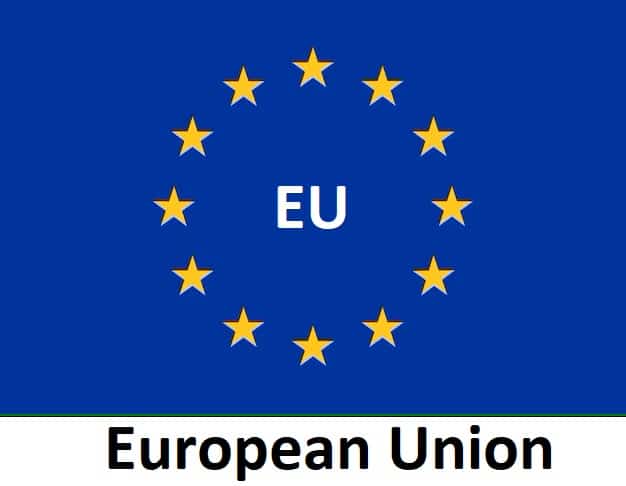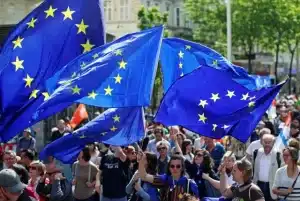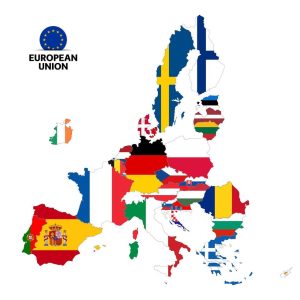Headlines
European Union: A History of Integration, Challenges, and Achievements

The European Union (EU) is a unique political and economic union of 27 member states that share common values and policies. The EU has its origins in the aftermath of World War II, when a group of visionary leaders decided to create a community of European nations that would cooperate peacefully and promote democracy, human rights, and prosperity. This article will provide an overview of the history of the EU and how it was founded.
See Population, Official Language And More…

European Union

European Union
The first step towards the EU was the establishment of the European Coal and Steel Community (ECSC) in 1951. The ECSC was an agreement between six countries: France, Germany, Italy, Belgium, the Netherlands, and Luxembourg. The ECSC aimed to integrate the coal and steel industries of these countries, which were essential for war production, and to prevent future conflicts between them. The ECSC was based on the idea of a supranational authority that would oversee the common market and ensure fair competition. The ECSC was proposed by Robert Schuman, the French foreign minister, in a speech on May 9, 1950, which is now celebrated as Europe Day.
The success of the ECSC led to the creation of two more communities in 1957: the European Economic Community (EEC) and the European Atomic Energy Community (EAEC). The EEC aimed to create a common market for goods, services, capital, and labor among its members, while the EAEC focused on developing nuclear energy for peaceful purposes. The EEC and the EAEC were established by the Treaty of Rome, which was signed by the same six countries as the ECSC. The Treaty of Rome also introduced the concept of a European citizenship, which granted certain rights and freedoms to the citizens of the member states.
The EEC expanded its membership and its scope over the next decades. In 1973, Denmark, Ireland, and the United Kingdom joined the EEC, bringing the number of members to nine. In 1979, the first direct elections to the European Parliament were held, giving a voice to the people of Europe. In 1986, Spain and Portugal joined the EEC, and the Single European Act was signed, which aimed to create a single market by 1992. In 1992, the Maastricht Treaty was signed by 12 member states, creating the European Union as we know it today. The Maastricht Treaty established three pillars of cooperation: the European Communities (which included the ECSC, the EEC, and the EAEC), the Common Foreign and Security Policy (CFSP), and the Justice and Home Affairs (JHA). The Maastricht Treaty also introduced the Economic and Monetary Union (EMU), which led to the creation of a single currency, the euro.
The EU continued to grow and deepen its integration in the 21st century. In 1995, Austria, Finland, and Sweden joined the EU. In 1999, 11 member states adopted the euro as their official currency. In 2002, the ECSC expired after 50 years of existence. In 2004, 10 new countries joined the EU: Cyprus, Czech Republic, Estonia, Hungary, Latvia, Lithuania, Malta, Poland, Slovakia, and Slovenia. In 2007, Bulgaria and Romania joined the EU, and the Treaty of Lisbon was signed by 27 member states. The Treaty of Lisbon reformed the EU’s institutions and policies, merging the three pillars into a single legal entity. The Treaty of Lisbon also gave more power to the European Parliament and introduced new mechanisms for democratic participation such as the European Citizens’ Initiative. In 2009, Croatia became the 28th member state of the EU.
The EU has faced many challenges and opportunities in its history. Some of them include:
- The enlargement process that has brought diversity and dynamism to the EU but also raised questions about its identity and cohesion.
- The financial crisis that started in 2008 that tested the solidarity and stability of the eurozone and required unprecedented measures such as bailouts and fiscal coordination.
- The migration crisis that started in 2015 that exposed the weaknesses of the EU’s asylum system and triggered debates about border security and human rights.
- The Brexit referendum that took place in 2016 that resulted in the United Kingdom’s decision to leave the EU after 47 years of membership.
- The COVID-19 pandemic that started in 2020 that posed a major threat to public health and economic recovery and called for a coordinated response from all levels of governance.
The EU has also achieved many accomplishments and benefits for its citizens. Some of them include:
- The creation of a single market that has enabled free movement of goods, services, capital, and people across borders.
- The establishment of a common currency that has facilitated trade and travel within the eurozone.
- The development of common policies that have addressed issues such as climate change, energy, agriculture, trade, competition, consumer protection, and social cohesion.
- The promotion of peace and democracy both within and outside the EU, through dialogue, diplomacy, and development cooperation.
- The enhancement of cultural diversity and identity, through programs such as Erasmus, Creative Europe, and European Capitals of Culture.
The EU is a unique and evolving project that has shaped the history of Europe and the world. The EU is based on the values of human dignity, freedom, democracy, equality, the rule of law, and respect for human rights. The EU is also guided by the principles of subsidiarity and proportionality, which ensure that decisions are taken as close as possible to the citizens and that the EU only acts when necessary. The EU is a community of law, which means that its actions are based on treaties that are agreed by all member states. The EU is also a community of interests, which means that its members work together to achieve common goals and to defend their shared interests. The EU is a community of destiny, which means that its members share a common vision and a common future.
The European Union is a remarkable achievement of political and economic integration that has brought many benefits to its citizens and the world. Here are some different details on the above subject:
- The EU has a complex institutional structure that involves seven main institutions and several other bodies and agencies. The main institutions are: the European Parliament, which represents the people of the EU and shares the legislative power with the Council; the European Council, which defines the general political direction and priorities of the EU; the Council of the European Union, which represents the governments of the member states and shares the legislative power with the Parliament; the European Commission, which proposes and implements laws, manages the budget, and represents the EU internationally; the Court of Justice of the European Union, which ensures that EU law is respected and interpreted uniformly; the European Central Bank, which manages the euro and conducts monetary policy; and the European Court of Auditors, which checks the legality and soundness of EU finances.
- The EU has achieved many milestones in its history, such as: creating a single market that allows free movement of goods, services, capital, and people across borders; establishing a common currency, the euro, that is used by 19 member states and over 340 million people; winning the Nobel Peace Prize in 2012 for its contribution to peace and reconciliation in Europe and beyond; abolishing the death penalty in all member states and promoting human rights and democracy; launching ambitious policies to tackle climate change and environmental challenges; providing aid and development assistance to millions of people around the world; enhancing cultural diversity and identity through programs such as Erasmus, Creative Europe, and European Capitals of Culture.
- The EU also faces many challenges and opportunities in its present and future, such as: managing the consequences of Brexit, which is the withdrawal of the United Kingdom from the EU after 47 years of membership; dealing with the impact of the COVID-19 pandemic, which has posed a major threat to public health and economic recovery; strengthening its security and defence cooperation in a changing global context; addressing the migration crisis and reforming its asylum system; fostering social cohesion and solidarity among its citizens; enhancing its digital transformation and innovation potential; expanding its enlargement process and neighbourhood policy.





